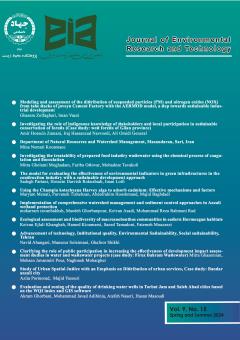Modeling and assessment of the distribution of suspended particles (PM) and nitrogen oxides (NOX) from the stacks of joveyn Cement Factory with the AERMOD model, a step towards sustainable industrial development
Subject Areas : air pollution
Ghasem Zolfaghari
1
![]() ,
Iman Vaezi
2
,
Iman Vaezi
2
1 - Department of Environmental Sciences and Engineering, Faculty of Environmental Sciences, Hakim Sabzevari University, Sabzevar, Iran
2 - 2- Associate Professor, Department of Environmental Sciences and Engineering, Faculty of Environmental Sciences, Hakim Sabzevari University, Sabzevar, Iran
Keywords: Environmental pollutants, Emission rate, Ambient air quality standard, Cement industry,
Abstract :
|
With the development of industries in developing countries, air pollution is a serious threat to health and public health. Sustainable development is a process that envisages a favorable future for human societies. In the sustainable development system, human needs are met by using resources without harming the integrity, beauty and stability of vital systems. The main goal of this study is to simulate the dispersion of suspended particles (PM) and nitrogen oxides (NOX) from the stacks of the joveyn cement factory using the AERMOD8.9 software developed by the Environmental Protection Agency (US EPA). Also, the obtained results were compared with the open air quality standard of Organization of Environmental Protection and the global standard of EPA and also, some solutions were provided to reduce pollutants. The results of the modeling show that the concentration of suspended particles in the 24-hour data of the autumn season is 47.7 µg/m3 and for the summer season it is 31.7 µg/m3, which occurs at a distance of 6370 meters from the emission source. The predicted concentration of suspended particles in each of the summer and autumn seasons in a 24-hour period was lower than the international outdoor air quality standard (EPA) and the Iranian environmental standard; its value was equal to 150 µg/m3. |
The estimated concentration of the model for NOX in 24-hour data is 92.44 µg/m3 for the summer season and 39.33 µg/m3 for the autumn season and occurs at the distances of 1950 and 2600 meters from the source, respectively. The predicted concentration of NOX in each of the summer and autumn seasons in a 24-hour period was lower than the standards of the international air quality standard (EPA) of 53 µg/m3 and the Iranian environmental standard of 200 µg/m3. Emission models in industries help to make the necessary changes in line with the sustainable development of the industry.
